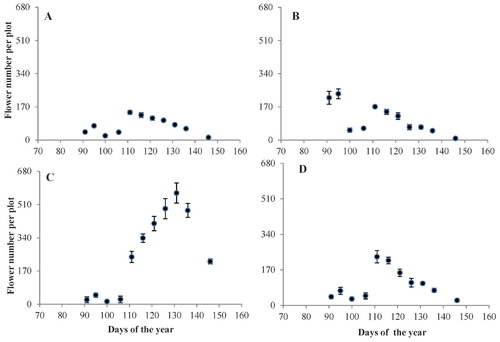Figures & data
FIGURE 1. Means (±1 SE) of (A) the number of blue and protogynous flowers, (B) white and protogynous flowers, (C) blue and protandrous flowers, and (D) white and protandrous flowers during the flowering season. n = 5.

TABLE 1 Results of three-way ANOVAs showing the effects of dichogamy-type (protogyny vs. protandry), flower color (white vs. blue), and flowering stage (early, middle, and late) on flower number per plot, plant height, aboveground plant biomass, flower mass fraction, stem mass fraction, leaf mass fraction, total seed mass per flower, seed mass, total seed number per flower, and seed set ratio for G. leucomelaena.
Table
Table
TABLE 2 Biomass allocation, shoot height and reproductive efficiency at three flowering stages for four types of flowers of G. leucomelaena.
FIGURE 2. Means (±1 SE) pollinator visitation rates for four flower types [blue and protogynous flowers (BG), white and protogynous flowers (WG), blue and protandrous flowers (BT), and white and protandrous flowers (WT)] at the (A) middle and (B) late stages of the flowering period. The means are daily averages, which were calculated from hourly observations. n = 5 observations per day for each flower type.
![FIGURE 2. Means (±1 SE) pollinator visitation rates for four flower types [blue and protogynous flowers (BG), white and protogynous flowers (WG), blue and protandrous flowers (BT), and white and protandrous flowers (WT)] at the (A) middle and (B) late stages of the flowering period. The means are daily averages, which were calculated from hourly observations. n = 5 observations per day for each flower type.](/cms/asset/d935abf6-86e3-462d-9f3c-64fa4b79c996/uaar_a_11957758_f0006.jpg)
FIGURE 3. Means (±1 SE) of (A) seed yield (total seed mass), (B) seed number, and (C) seed mass for each of the four types of flowers [blue and protogynous flowers (BG), white and protogynous flowers (WG), blue and protandrous flowers (BT), and white and protandrous flowers (WT)] during the flowering season. n = 30 for each flower morph. The different letters above the error bars denote significant difference (P < 0.05) among the four flower types.
![FIGURE 3. Means (±1 SE) of (A) seed yield (total seed mass), (B) seed number, and (C) seed mass for each of the four types of flowers [blue and protogynous flowers (BG), white and protogynous flowers (WG), blue and protandrous flowers (BT), and white and protandrous flowers (WT)] during the flowering season. n = 30 for each flower morph. The different letters above the error bars denote significant difference (P < 0.05) among the four flower types.](/cms/asset/16db1282-8839-4a8a-80bf-d24f909678b0/uaar_a_11957758_f0007.jpg)
FIGURE 4. Fruit set (%) following (A) natural pollination and (B) hand pollination; and seed set (%) following (C) natural pollination and (D) hand pollination for each of the four types of flowers [blue and protogynous flowers (BG), white and protogynous flowers (WG), blue and protandrous flowers (BT), and white and protandrous flowers (WT)] during the flowering season. The different letters above the error bars denote significance difference (P < 0.05) between flower types or stages. n = 17 for fruit set in the early flowering stage, and n = 20 in both middle and late flowering stages. n = 30 for seed set except for the white protogynous flower morphs in early flowering stage (n = 25) and white protandrous flower morphs in later stage (n = 25).
![FIGURE 4. Fruit set (%) following (A) natural pollination and (B) hand pollination; and seed set (%) following (C) natural pollination and (D) hand pollination for each of the four types of flowers [blue and protogynous flowers (BG), white and protogynous flowers (WG), blue and protandrous flowers (BT), and white and protandrous flowers (WT)] during the flowering season. The different letters above the error bars denote significance difference (P < 0.05) between flower types or stages. n = 17 for fruit set in the early flowering stage, and n = 20 in both middle and late flowering stages. n = 30 for seed set except for the white protogynous flower morphs in early flowering stage (n = 25) and white protandrous flower morphs in later stage (n = 25).](/cms/asset/93c10131-41ad-4faa-b3e7-e5bc03d1c39e/uaar_a_11957758_f0008.jpg)
FIGURE 5. A schematic of the interrelationships among seed productivity, pollinator and resource availabilities, and the three stages in the flowering season (early, middle, and late; see ). Seed productivity is a function of the availability of pollinators (insects) and resources (e.g., light and soil nutrients). The availability of pollinators increases from the early- to the late-flowering stage; the availability of resources decreases from the early- to the late-flowering stage. These two opposing trends result in maximum seed productivity during the middle-flowering stage, but permit limited seed yield across the entire flowering season.

